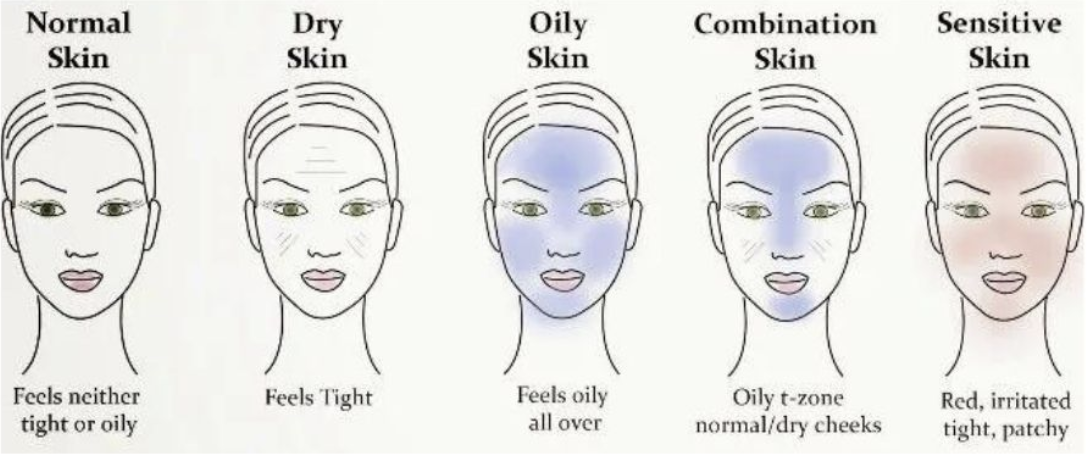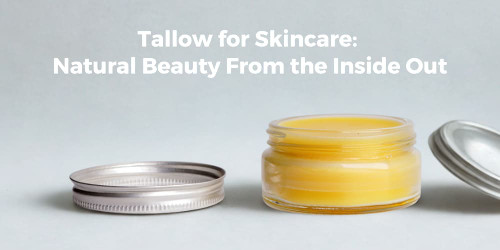How to know your skin type
The skin is the body’s largest organ and acts as its first line of defense from pathogens. It has important roles in insulation, immunity, temperature regulation, sensation, and Vitamin D production. While the skin is resilient and able to heal itself, it requires a level of care to keep it clean and to avoid skin damage and disease. To understand your skin’s needs and care for it properly, you first need to understand what type of skin you have. Read on for a closer look at what’s really getting under your skin.
How Many Skin Types Are There?
There are five different skin types: oily, dry, normal, combination, and sensitive.

Photo taken from Gunilla Organic Skincare
- Oily: This type of skin produces an excessive amount of sebum; a natural substance produced by the skin’s sebaceous glands. The build-up of sebum clogs the pores and makes the skin appear shiny or greasy. Oily skin is prone to breakouts.
- Dry: Dry skin doesn’t produce enough sebum, which can cause it to crack, flake, or peel. It will feel tight and is likely to display signs of premature aging, such as fine lines.
- Normal: This type of skin is even and smooth, with few blemishes or other concerns.
- Combination: Combination skin displays the characteristics of two or more different skin types in different areas. The most common combination is dry-oily, with excess oil produced across the T-Zone (forehead, nose, and chin) and dryness over the cheeks.
- Sensitive:
This skin type is characterized by mild irritation when exposed to stressors. The skin may show visible signs of sensitivity, such as redness and flaking, and it may feel itchy and uncomfortable.
Can Skin Types Change?
Yes, Skin type can change as a result of age, hormonal changes, stress levels, diet, or varying environmental conditions. Most of us go through a period of breakouts during our teenage years, and many women experience a change in skin type during or after pregnancy and menopause. Skin can be frustratingly unpredictable, and may change frequently over short or long periods of time, requiring adjustments to your skin care routine to protect your skin’s integrity.
If you notice your skin becoming drier, you should treat it with a gentle, hydrating cleanser and a rich moisturiser. If your skin is becoming oilier, clean it twice a day with a purifying face wash, exfoliate regularly, and use a lighter moisturizer. For skin that is displaying combination characteristics, use a cleanser that reduces oil without stripping the skin of moisture, and opt for a hydrating, oil-free moisturiser.
How to Test Your Skin Type at Home
Determining your skin type is generally a simple, straightforward process of observation. The following at-home tests will provide an understanding of how your skin behaves.
The Bare-Faced Test
Step 1: Wash your face with a gentle cleanser, then pat it dry with a clean towel. Do not apply any products to the skin.
Step 2: Wait 30 minutes.
Step 3: Examine your skin in a mirror.
Oily skin will appear shiny; this oil will be distributed across the face. Combination skin may appear shiny over the T-Zone, while the rest of the face will likely be normal and matte.
Dry skin will feel tight and may be flaky, while sensitive skin may be itchy, red, or inflamed. Normal skin will be smooth and even with small pores and minimal oil, flakiness, and redness. It will feel hydrated and comfortable.
The Blotting Sheet Test
Step 1: Wash your face with a gentle cleanser, then pat it dry with a clean towel. Do not apply any products to the skin.
Step 2: Wait 30 minutes.
Step 3: Pat a sheet of blotting paper over your face.
Step 4: Hold the blotting paper up to the light. Examine the oil distribution.
If there is an abundance of oil from all areas of your face, you have oily skin. If the oil is concentrated from the T-Zone area, you have combination skin.
If there is almost no oil on the paper, you have dry skin. If there is minimal oil that is evenly distributed, you likely have normal skin. Sensitive skin is prone to inflammation and breakouts and may produce oil unevenly across the face.
Online Skin Type Tests:
There are many free skin type tests available online. They can more or less accurately diagnose your skin type and some even prescribe a custom skin care routine in their medical practice. Here are some online websites you can go to:
- Skin Type Quiz by Skin Type Solutions
- Skin Care Quiz: What’s Your Skin Type? By Healthline
- Skin Type Test & Quiz by Brisbane Cosmetic Clinic
Note: This skin type test is for informational purposes only and not a substitute for professional medical advice. Individual results may vary. Consult a dermatologist for personalized advice. By using this test, you acknowledge it doesn't constitute medical advice and assume responsibility for decisions made based on the results.
Can You Have a Combination of Skin Types?
Many people have a combination of skin types, which can be difficult to care for. Combination skin is usually caused by genetic factors but can be influenced and exacerbated by fluctuations in hormones, diet, age, and environmental conditions. Most people with this skin type have an oily T-Zone and dry cheeks, though some people exhibit patches of more than two different skin types. The best way to balance combination skin is by using a gentle cleanser and moisturiser in the morning and evening, sunscreen during the day, and a gentle exfoliant to remove dead skin cells and unblock pores.
Products to Avoid for Each Skin Type?
Normal skin
- Avoid harsh exfoliants. Though normal skin is relatively balanced, using abrasive scrubs or over-exfoliating can damage the skin’s barrier and lead to irritation. Opt for gentle chemical exfoliants or mild physical scrubs instead.
- Steer clear of alcohol-based products. Alcohol can strip your skin of its natural oils, leading to dryness and sensitivity.
- Pay attention to hydration. It’s essential to keep your skin moisturised even if it feels balanced. Choose lightweight moisturisers with hyaluronic acid, glycerin, or other hydrating ingredients.
Dry skin
- Avoid products with drying ingredients. Steer clear of products containing alcohol, sulfates, and harsh detergents that can exacerbate dryness. Instead, look for gentle cleansers and creams with nourishing ingredients like ceramides, shea butter, or jojoba oil.
- Don’t over-exfoliate. Limit exfoliation to once or twice a week and opt for gentle chemical exfoliants like lactic acid or PHAs, which are less likely to irritate dry skin.
- Skip long, hot showers. Prolonged exposure to hot water can strip your skin of natural oils, worsening dryness. Opt for shorter, lukewarm showers instead.
Oily skin
- Avoid comedogenic ingredients. Steer clear of heavy, pore-clogging ingredients like mineral oil, coconut oil, shea butter, and petrolatum. Instead, look for non-comedogenic, oil-free products that won’t exacerbate oiliness or cause breakouts.
- Don’t over-cleanse. Overwashing your face can strip your skin of natural oils, leading to increased oil production. Instead, try cleansing twice daily with a gentle, foaming cleanser.
- Avoid harsh acne treatments. While using potent acne-fighting ingredients like benzoyl peroxide is tempting, be cautious not to overdo it. Using too much can cause irritation and dryness, leading to more oil production and breakouts. Glycolic acids can work well for acne skin.
Combination skin
- Don’t use one-size-fits-all products. Avoid products that are too heavy for your oily areas or too light for your dry areas. Instead, consider using different products for each zone or opt for products specifically designed for combination skin.
- Avoid over-drying toners. Skip alcohol-based toners that can worsen dryness in certain areas. Instead, choose gentle, alcohol-free toners with balancing ingredients like witch hazel or niacinamide.
- Don’t neglect exfoliation. Ensure you exfoliate gently and regularly, as combination skin can benefit from the removal of dead skin cells and excess oil. Use a gentle glycolic exfoliant to avoid irritation.
Sensitive skin
- Avoid harsh ingredients. Steer clear of products containing alcohol, fragrance, synthetic dyes, or other potential irritants. Instead, opt for hypoallergenic, fragrance-free products formulated for sensitive skin.
- Don’t over-exfoliate. Exfoliating too frequently or using harsh scrubs can exacerbate sensitivity. Instead, limit exfoliation to once a week and choose gentle chemical exfoliants like PHAs or low-concentration lactic acid.
- Avoid aggressive treatments. Some chemical peels, heavy microdermabrasion, and certain laser treatments can be too harsh for sensitive skin
Conclusion
Now that you know how to determine your skin type and care for it accordingly, you can develop a complete skincare routine that hydrates, repairs and protects. Medcart stocks a range of skincare products suitable for all skin types, so you can cleanse, exfoliate, and moisturize your way to smooth, silky perfection.















